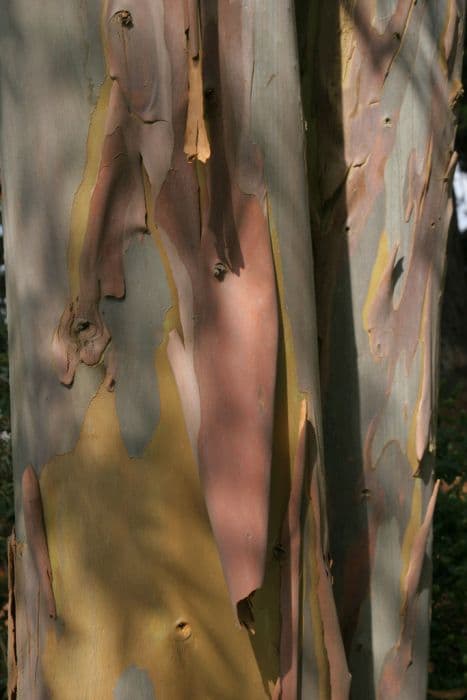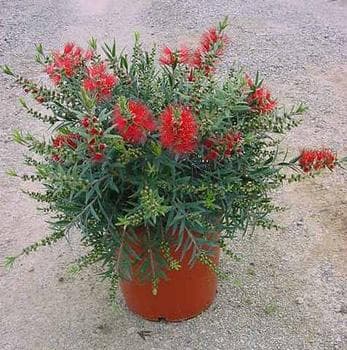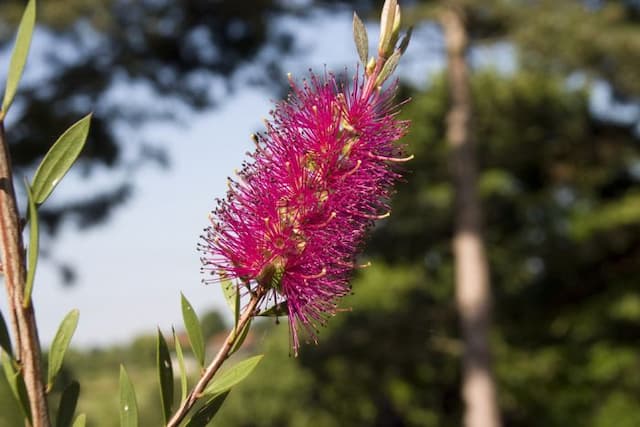Alpine Tea Tree Leptospermum rupestre

ABOUT
Leptospermum rupestre, widely recognized as the alpine tea tree, showcases a robust and woody appearance typical of many shrub-like plants. The alpine tea tree has small, densely packed leaves that are evergreen, retaining their color and vitality throughout the seasons. These leaves exhibit a somewhat oval or lance-shaped outline and may possess a leathery texture. The alpine tea tree produces delicate, five-petaled flowers that usually blossom in a generous array of white tones, though they can also appear in shades of pink. The flowers are a stark contrast to the darker foliage, providing a striking visual display. The blooms often feature a central cluster of small, dark seed capsules which remain on the plant for extended periods after flowering. This combination of evergreen foliage and persistent seed capsules gives the alpine tea tree a distinctive character throughout the year.
About this plant
 Names
NamesFamily
Myrtaceae
Synonyms
Alpine Tea Tree, Mountain Tea Tree
Common names
Leptospermum rupestre.
 Toxicity
ToxicityTo humans
Leptospermum rupestre, commonly known as alpine tea-tree, does not have a well-documented profile of toxicity to humans. There is no significant evidence to suggest that the Alpline Tea-tree is toxic when touched or ingested. However, as with many plants, individual allergies can occur. It is always advisable to exercise caution and avoid ingesting plants not known to be safe for consumption. If accidental ingestion does occur and symptoms appear, it is important to seek medical advice.
To pets
Information specific to the toxicity of Leptospermum rupestre, or alpine tea-tree, to pets is not widely documented. The Alpine Tea-tree does not appear on common lists of plants that are known to be toxic to pets. However, it is generally recommended to prevent pets from ingesting plants not known to be safe, as individual animals may have different sensitivities or allergic reactions. If your pet does consume any part of this plant and shows signs of distress or illness, contact your veterinarian promptly.
 Characteristics
CharacteristicsLife cycle
Perennials
Foliage type
Evergreen
Color of leaves
Green
Flower color
White
Height
3 feet (0.91 meters)
Spread
5 feet (1.52 meters)
Plant type
Shrub
Hardiness zones
9
Native area
Australia
Benefits
 General Benefits
General Benefits- Erosion control: Its roots help to stabilize soil in rocky areas, preventing the loss of topsoil due to water or wind.
- Habitat for wildlife: Provides shelter and food for a variety of insects and birds.
- Aesthetic appeal: Its attractive blossoms and evergreen foliage can enhance the beauty of gardens and natural landscapes.
- Drought tolerance: Once established, it can withstand periods of low rainfall, reducing the need for irrigation.
- Low maintenance: Typically requires little care or intervention once established in a suitable environment.
 Medical Properties
Medical PropertiesThis plant is not used for medical purposes.
 Air-purifying Qualities
Air-purifying QualitiesThis plant is not specifically known for air purifying qualities.
 Other Uses
Other Uses- Leptospermum rupestre, commonly known as alpine tea-tree, can be used in crafting and floral arrangements due to its sturdy branches and attractive, fine foliage which adds texture and interest to bouquets.
- The wood of the alpine tea-tree is dense and can be used for making small woodworking items like decorative handles, ornaments, and jewelry.
- Due to its compact growth habit, the alpine tea-tree can be cultivated as a bonsai, providing an artistic and intricate display of miniaturized natural beauty.
- Alpine tea-tree's essential oil, although not widely known, can sometimes be used in perfumery to impart a woodsy and unique base note.
- The flowers of the alpine tea-tree can serve as a natural dye source, imparting subtle colors to fabrics and yarns.
- Because of its resilience and ability to grow in rocky soils, Leptospermum rupestre can be used in erosion control and landscaping on sloped terrains.
- The plant can be grown as a privacy screen in gardens due to its dense foliage and can be pruned into formal hedges or kept natural for a more rustic look.
- Alpine tea-tree's pleasing aesthetic makes it suitable for use in model making and dioramas, particularly to replicate trees and shrubs in miniature landscapes.
- Culinary enthusiasts sometimes use the dried leaves of the alpine tea-tree as a herb for infusing dishes with a subtle, tea-like flavor, although this is not a common practice.
- The striking appearance of alpine tea-tree in bloom can be captured in photography and used as a subject for nature-inspired art and design projects.
Interesting Facts
 Feng Shui
Feng ShuiThe Australian tea tree is not used in Feng Shui practice.
 Zodiac Sign Compitability
Zodiac Sign CompitabilityThe Australian tea tree is not used in astrology practice.
 Plant Symbolism
Plant Symbolism- Resilience: Leptospermum rupestre, also known as Alpine Tea-tree, typically grows in rocky and alpine environments, symbolizing the ability to thrive under challenging conditions and adversity.
- Retreat: As a plant found in secluded areas, the Alpine Tea-tree can represent a retreat or escape from the outside world, suggesting introspection and personal sanctuary.
- Adaptation: The ability of the Alpine Tea-tree to adapt to its harsh, mountainous habitat makes it a symbol for flexibility and the capacity to adjust to new situations.
- Purity: The Alpine Tea-tree’s natural habitat is often associated with unspoiled wilderness, giving it a symbolic association with purity and cleanliness.
- Healing: As some species of Leptospermum are used for their medicinal properties, the Alpine Tea-tree can symbolize healing and the soothing of ailments.
 Water
WaterAustralian tea tree, or Leptospermum rupestre, should be watered deeply but infrequently to mimic its natural environment. Allow the topsoil to dry out between waterings, which typically means watering every 1-2 weeks, depending on climate and soil conditions. During active growth in the spring and summer, aim for about 1-2 gallons per watering for an established shrub, adjusting for rainfall as necessary. Reduce watering in the fall and further in the winter when the plant's growth slows down, to prevent root rot from excess moisture.
 Light
LightAustralian tea tree thrives in full sun to partial shade. It performs best when it receives at least 6 hours of direct sunlight daily. An ideal spot would be a south-facing or west-facing location where the plant can bask in the sun's rays. If planted indoors, a bright sunny window or a spot under grow lights that simulate full spectrum light would be beneficial.
 Temperature
TemperatureAustralian tea tree prefers moderate temperature conditions and can tolerate a range from about 40°F to 80°F. The ideal temperature for thriving growth is between 60°F to 70°F. This plant can survive brief periods of colder weather and even light frosts but should be protected from prolonged exposure to temperatures below 30°F.
 Pruning
PruningPrune the Australian tea tree to maintain its shape and promote dense growth. Pruning should be done in the late winter or early spring before new growth begins. It’s often enough to prune once a year, but if the plant is growing vigorously, a second light pruning in the summer may be beneficial. Remove any dead or damaged branches and thin out overly crowded areas to improve air circulation.
 Cleaning
CleaningAs needed
 Soil
SoilAlpine Tea Tree thrives in well-draining, acidic soil with a pH between 5.5 and 6.5. A mix of peat, sand, and loam is ideal to ensure proper drainage and aeration.
 Repotting
RepottingAlpine Tea Tree should be repotted every two to three years to prevent root-bound conditions and replenish nutrients in the soil.
 Humidity & Misting
Humidity & MistingAlpine Tea Tree prefers moderate to high humidity levels, typically around 50-70%, avoiding extremely dry environments.
 Suitable locations
Suitable locationsIndoor
Place Alpine Tea Tree near a sunny window and ensure good air circulation.
Outdoor
Plant in well-drained soil in a sunny spot, protect from harsh winds.
Hardiness zone
7-9 USDA
 Life cycle
Life cycleLeptospermum rupestre, commonly known as alpine tea-tree, begins its life as a seed which germinates in moist, well-draining soil, ideally in areas with full sun to partial shade. After germination, the seedling goes through a growth phase where it develops a root system and foliage, becoming a juvenile plant. As it matures, the alpine tea-tree enters the vegetative stage, establishing a more extensive root system and producing characteristic narrow leaves. The reproductive stage follows, where the plant blossoms with small, white flowers that attract pollinators, leading to the development of woody capsules that contain seeds. After pollination and seed development, the plant enters a period of seed dispersal, where the capsules release seeds to begin a new generation. The alpine tea-tree is a perennial shrub, so this cycle of growth, flowering, and seed production can occur annually throughout its lifespan.
 Propogation
PropogationPropogation time
Spring-Early Summer
Leptospermum rupestre, commonly known as Alpine Tea-tree, can be propagated most effectively through the method of seed sowing. The best propagation time is typically in the spring after the last frost when temperatures are consistently warm, to optimize seed germination. To start the seeds, they should be sown on the surface of a well-draining seed raising mix and kept moist. It's often not necessary to cover the seeds with soil, as they require light for germination. A warm position with indirect sunlight is ideal for encouraging growth. After the seedlings have developed a couple of sets of true leaves and are large enough to handle, they can be transplanted into individual pots to continue growing until they are ready to be moved outdoors.









